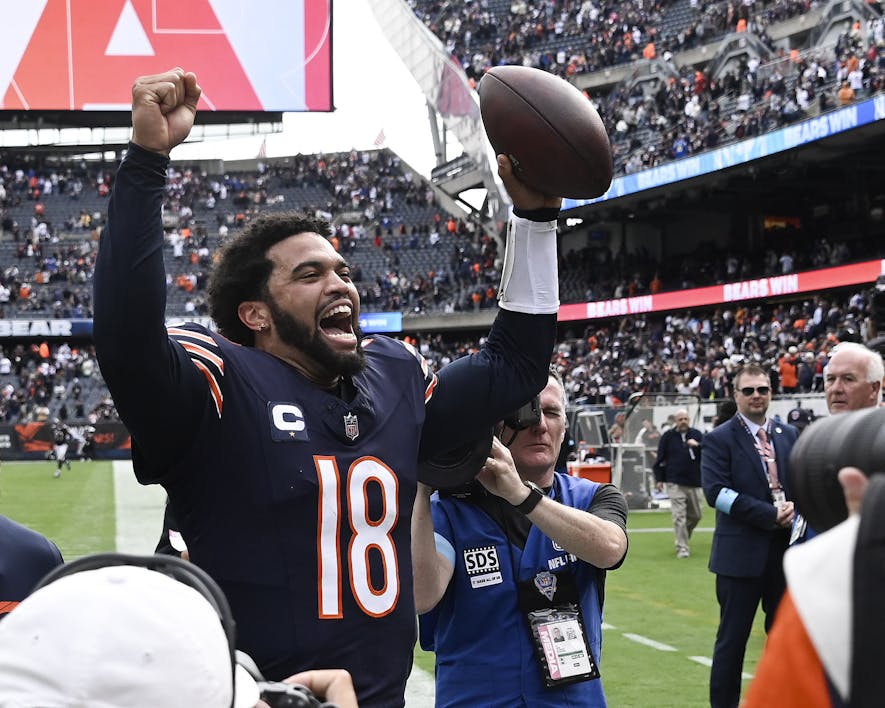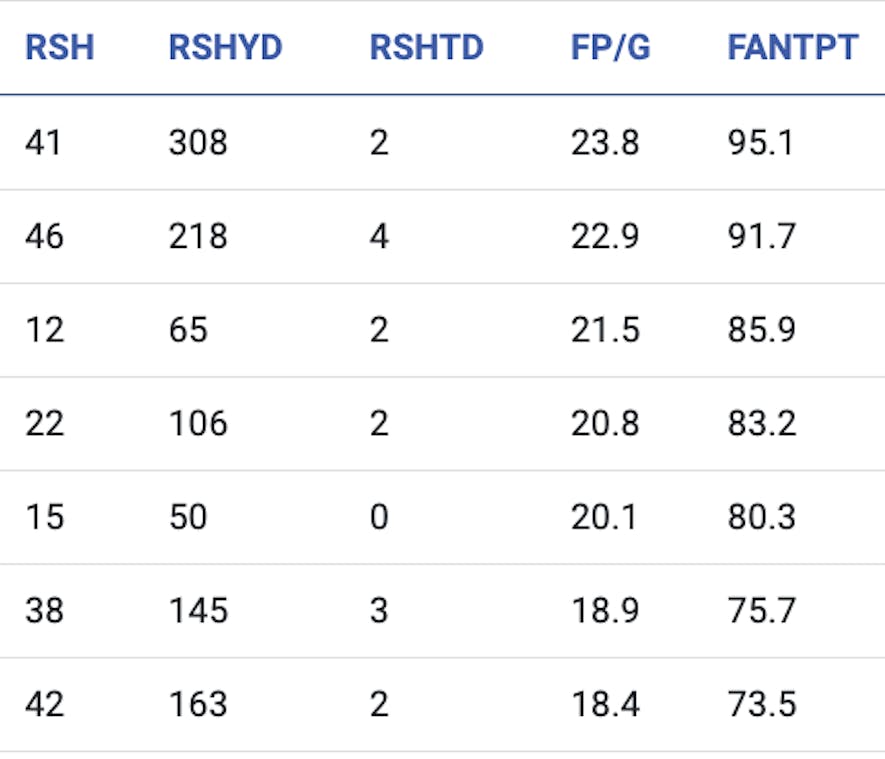Did the Bears make a mistake drafting Caleb Williams over Jayden Daniels?
The online debate over this topic last week was both intriguing and a perfect example of the valuations we must make early in NFL players' careers to gain an edge on our competition.
Kevin Cole (Unexpected Points) argued that, based on the draft history of first overall versus second overall picks, there was roughly a 55% chance the Bears made the right call (at the time of the pick) and a 45% chance they should have drafted Daniels instead. This sets an important baseline for any of these discussions. Adam Harstad has regularly written about approaching fantasy player valuations through the lens of Bayesian statistics.
In Bayesian terms, prior probability is the likelihood of an event before new data is introduced. It represents the best rational assessment of an outcome's chance based on current knowledge, before new information (or in our case, the NFL season) unfolds. Here, the prior probability equates to preseason expectations. As the season progresses, we update this with posterior probability—the new likelihood after incorporating fresh data, such as what we've observed in the first quarter of the season.
Now that we've seen enough games to update our prior beliefs, it seems increasingly likely—maybe a 65% chance (?)—that Jayden Daniels will have the better career. Odds may be even higher that he has the more valuable fantasy career. His early-season performance has been nothing short of remarkable. The Commanders currently boast the second-most efficient offense (EPA per drive) through the first four weeks of a season in the past 25 years. Daniels has been a big part of this success, with an 82.1% completion percentage that's still on the rise; he's completed an astonishing 89% of his throws over the past two weeks. On the ground, he's already rushed for 218 yards and four touchdowns, all while avoiding big hits—a crucial skill for a quarterback with his dual-threat style. Additionally, we're seeing the same early locker room buy-in from teammates that we saw with C.J. Stroud last season. Put differently, the vibes are way more positive in Washington than in Chicago. Daniels seems to have already convinced his teammates he is on the path to superstardom. You cannot say the same about Williams and his Chicago teammates.
The real key to gaining an edge in dynasty leagues is mastering how to weigh this new information against our preseason expectations. As we head into October, recalibrating and forming new outlooks based on early-season data is crucial. Given this is a monthly article, the focus will be on early-season trends as opposed to short-term usage changes.
In this month's Dynasty Trade Value Chart article, we'll dive deeper into these ideas, focusing on the following topics:
- A decrease in quarterback fantasy production overall and an increased reliance on rushing production to score fantasy points
- Valuing Patrick Mahomes II
- A change in how running backs are being used
- Rashee Rice versus 2025 rookie picks
- Recognizing the Upside in Jayden Reed
- The drop in tight end production and how it impacts strategy.
- The emerging 1.01 in 2025 rookie drafts
Quarterback
| Player | Team | One QB | Superflex |
|---|---|---|---|
| Josh Allen | BUF | 23 | 58 |
| Jayden Daniels | WAS | 21 | 55 |
| C.J. Stroud | HOU | 20 | 54 |
| Lamar Jackson | BAL | 20 | 53 |
| Patrick Mahomes II | KC | 18 | 52 |
| Joe Burrow | CIN | 15 | 45 |
| Jordan Love | GB | 14 | 43 |
| Jalen Hurts | PHI | 15 | 42 |
| Kyler Murray | ARI | 14 | 41 |
| Caleb Williams | CHI | 9 | 38 |
| Brock Purdy | SF | 8 | 35 |
| Anthony Richardson | IND | 10 | 34 |
| Justin Herbert | LAC | 7 | 33 |
| Dak Prescott | DAL | 7 | 28 |
| Jared Goff | DET | 6 | 28 |
| Drake Maye | NE | 6 | 26 |
| Trevor Lawrence | JAX | 5 | 23 |
| Baker Mayfield | TB | 5 | 20 |
| Tua Tagovailoa | MIA | 5 | 20 |
| Justin Fields | PIT | 6 | 19 |
| Sam Darnold | MIN | 5 | 16 |
| Michael Penix Jr. | ATL | 3 | 15 |
| Bo Nix | DEN | 3 | 14 |
| Geno Smith | SEA | 4 | 12 |
| Matthew Stafford | LAR | 3 | 12 |
| J.J. McCarthy | MIN | 2 | 12 |
| Derek Carr | NO | 2 | 11 |
| Kirk Cousins | ATL | 3 | 11 |
| Will Levis | TEN | 2 | 9 |
| Deshaun Watson | CLE | 2 | 9 |
| Daniel Jones | NYG | 1 | 8 |
| Aaron Rodgers | NYJ | 2 | 8 |
| Bryce Young | CAR | 1 | 6 |
| Gardner Minshew II | LV | 1 | 4 |
| Andy Dalton | CAR | 1 | 4 |
| Malik Willis | TEN | 1 | 4 |
| Russell Wilson | PIT | 1 | 3 |
| Jacoby Brissett | NE | 0 | 3 |
| Jameis Winston | CLE | 1 | 3 |
| Tyler Huntley | BAL | 0 | 3 |
| Joe Flacco | IND | 1 | 3 |
| Aidan O'Connell | LV | 0 | 2 |
| Drew Lock | NYG | 0 | 2 |
Big Picture Trends: Scoring Down
Quarterback fantasy scoring is significantly down across the NFL. Through four weeks, only eight quarterbacks are averaging more than 18 fantasy points per game. To put that in perspective, at this same point in the 2020 season, 17 quarterbacks were averaging 18+ PPG. In 2021, that number was 18. Curious about how this year's low scoring compares to past seasons, I did some digging, and here's what I found:
We are clearly in a downturn when it comes to quarterback fantasy scoring. This is the third straight season with 11 or fewer quarterbacks averaging 18+ at this point in the season.
There's another trend worth noting: of the eight quarterbacks currently averaging 18+ PPG, one (Jordan Love) has only played two games. Six of the remaining seven have already scored multiple rushing touchdowns (Lamar Jackson, Josh Allen, Jayden Daniels, Jalen Hurts, Baker Mayfield, and Justin Fields). Sam Darnold is The only quarterback who averages 18+ PPG without at least 0.5 rushing touchdowns per game.
Here's the rushing production from the top seven fantasy quarterbacks this season:
In short, fantasy production from passing is way down. Aside from Love (who has only played two games), no quarterback is averaging 300 passing yards per game. The only difference-makers at the position, except for Darnold, are putting up relatively big numbers with their legs.
Looking forward, the major takeaway is that the days of 5,000-yard passers putting up huge numbers through the air look to be over, at least in the short term. This increases the value of quarterbacks with rushing upside. As such, we see guys like Josh Allen, Lamar Jackson, Justin Fields, and Jayden Daniels maintaining or increasing their dynasty trade values. On the other hand, Patrick Mahomes II, Justin Herbert, and others who score the vast majority of their fantasy points through the air have seen their values diminish.
Is it time to have the real-life value versus fantasy value conversation about Patrick Mahomes II? He's on a path to challenge Tom Brady as the greatest NFL player of all time, and there's no denying his talent or importance to the Chiefs. Kansas City is undefeated at 4-0, despite a tough early schedule, and Mahomes is the best player in the league.
However, from a fantasy perspective, the story is different. Mahomes is currently the QB18, averaging just 14.1 fantasy points per game after four weeks. This comes on the heels of last season, where he finished as the QB12 in points per game (17.9). This ties back into the bigger-picture trend above that has seen running quarterbacks separate from the pack.
With injuries to Rashee Rice and Marquise Brown, the hopes of Mahomes having a monster fantasy season are likely dashed. More importantly, this isn't the same Kansas City blueprint we saw in the early Mahomes years. Remember when he threw for 478 yards and six touchdowns in a 54-51 loss to the Rams? Those days are gone. Nobody is putting up 54 points against a Chiefs defense that has allowed fewer than 18 points per game over their last 20+ games, dating back to the start of 2023. The blueprint moving forward for the Chiefs is likely to include a balanced offensive approach and relatively conservative offensive approach many weeks because of positive game scripts due to the excellence of the defense.
From a dynasty perspective, Mahomes remains the safest of bets for long-term fantasy usefulness. We may just be entering a phase in which he is not an elite fantasy performer with the week-winning upside we have come to expect.
Continue reading this content with a ELITE subscription.
An ELITE subscription is required to access content for Dynasty leagues. If this league is not a Dynasty league, you can edit your leagues here.



